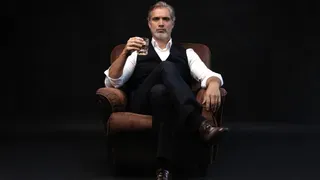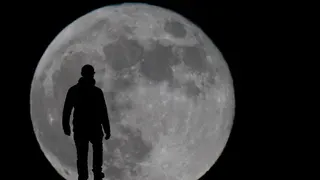June 23, 2013
Back to A Favorite Future :: 'Star Trek' Continues
Kilian Melloy READ TIME: 8 MIN.
"So you hated it?" Dieter asked.
"I didn't hate it. I just thought it was derivative in all the wrong ways, and narratively muddled, and miscast," I said. "Not to mention..." I found myself hesitating.
"Go on," Dieter prompted.
"Boring," I managed to spit out.
We could have been talking about most of the season's big budget tent pole movies, of course, because this is how I've felt about much of what I've seen so far this late spring-into-summer. ("Man of Steel?" Opulent to the eye, but a soul-parching expedition into a desert of swirling sands and little joy.)
But we weren't talking about just any movie experience. The subject at hand was the new "Star Trek" movie, titled... perhaps in a fashion that's a little too on the nose... "Into Darkness."
I expected Dieter to take issue with my pronouncement. He is, after all, a die-hard "Star Trek" fan and one of the few people I know who will actually defend the William Shatner-directed debacle that was 1988's "Star Trek V: The Final Frontier," an ill-advised venture into the metaphysical with Wild West overtones that nearly killed off the movie franchise.
"It's got good character interplay," is Dieter's refrain when the subject arises. "It's got heart."
Yeah, sure. Take that with a grain of dilithium, because Dieter actually watches the cartoon version of "Star Trek" on DVD.
But I digress. I was about to say that Dieter, to my complete surprise, didn't upbraid me for my blasphemous diss of the new movie. Instead, a few days later, he sent me a link complete with the "Alice In Wonderland"-esque command, "Watch Me."
What I found was, to my astonishment and delight, a dose of pure nostalgic love for the original series, right down to the 1960s stylings of dress and hair. Dieter had sent me a link to a fan series called "Star Trek Continues."
I've seen snippets of fan-made "Star Trek" films before. I have to say, most of what I have seen has been nothing short of dreadful. But here was an example of what a group of amateur filmmakers, actors, set builders, and costumers could do, given the advantages of contemporary filmmaking and its greatest innovations: CGI and digital filming, two electronic means to cheap, but effective, production.
I've often thought of the advent of high quality digital video as the modern-day equivalent of the printing press. Back when movable type was first created, it opened up whole new vistas for publishing by removing what had been an insurmountable obstacle to the dissemination of texts: Namely, the necessity, time-consuming as it was, of copying all written material by hand. Book lovers in the ancient world collected scrolls at no little expense, and it was sort of a big deal; compared to the flood of printed matter (and now posted material) that we have today, books were rare and precious.
Moreover, books in the old days were apt to be lost, despite occasional massive efforts to preserve them -- not surprising, really, given how few people were literate until the last century or so. (To get a sense for this, read Stephen Greenblatt's book "The Swerve," which recounts how one of antiquity's most important works -- maybe the most important work -- was thought lost for centuries, only to be rediscovered in the long-neglected collection of a monastery.)
With the printing press came the earliest form of mass market publication, and with it came all sorts of ephemera: Work that was polemical, or dull, or simply unimaginative and poorly written. But a richness and diversity of ideas was also possible, and this helped ideas flourish. There's been a lot of moaning about how the world is becoming homogenized thanks to the Internet, but that's only one part of the picture; as people from different cultures talk to one another, there's a great deal of cultural cross-pollination going on, and with that there comes a promise of revitalization. (Did you know, for example, that there's a Turkish version of "Star Trek?" It has lame production values, but that's not really the point.)
Forty-seven years ago, when the original "Star Trek" first aired, its special effects were so hard to achieve that getting a show done on time for weekly broadcasts was a real headache. Today, it can all be done inside a computer. What's needed, now as then, is passion and imagination. In the 1970s, after the show was cancelled by NBC, "Star Trek" fans started writing their own adventures; with typewriters and mimeographs, they prepared and disseminated the first "fanzines," crude publications dedicated to telling stories that were, often, equally amateurish. But it was something, and the show's adherents poured enormous passion into their fan fiction.
Take that kind of passion and apply it to the sorts of high-tech video tools of today, and you get... voila! "Star Trek Continues." The first episode, "Pilgrim of Eternity," premiered online a few weeks ago, starring James Doohan's son Christopher in the role of Scotty, and voice actor Vic Mignogna as Captain Kirk. (Not to spoil anything, but the episode also stars Michael Forest in a reprise of his Original Series role, the Greek God Apollo.)
I was dubious. Then the episode began, and I was thrilled. Unlike Chris Pine in the big-budget new films, Mignogna pulls off a performance that pays direct tribute to William Shatner's defining portrayal. No, not the strained and halting rhetoric of Shatner's over-the-top declamatory style... but a swaggering, smoldering air of space-dog sexuality that's physically summarized by a slightly forward-leaning posture, arms held a little tightly before the body, like an alpha-male ape asserting his dominance. Mignogna's voice seems totally wrong, at first, for the role, but you forget that when you see how precisely he copies Shatner's mannerisms, and there's a moment of shirtlessness in the new episode that's pure old-style Kirk, shaved chest and all.
Compare that to Pine, or to James Cawley, the producer and star of another well-done Trek fan series, "Star Trek: Phase II." Cawley is nothing like the muscular Kirk of Shatner's (and now Mignogna's) portrayal: Indeed, you never see Cawley's Kirk shirtless. (Cawley recently handed off the role to another actor, Brian Gross, who is equally wrong for the part, at least from a sheer physical perspective; Gross can be seen in a vignette in the role of Kirk, and he does possess a certain charisma that could make fans forget he's not the "real" Kirk, much as Cawley manages, for the most part, to do.)
At this point, you're wondering how I became such an expert on these fan-made, web-based shows. Here's how: I spent a weekend watching them, and marveling at how well done some of the visual effects were. In 1966, you could never have achieved the spectacular shots that Cawley's crew manages (and I have to tell you, for sheer visual spectacle, "Star Trek: Phase II" has an edge over "Star Trek Continues," though both series have evidently made it a mandate to include some visual wizardry in a mix that includes meticulous re-creations of sets, props, and uniforms).
I was also flabbergasted at the talent Cawley brought aboard his version of the Starship Enterprise. "Star Trek: Phase II" (previously titled "Star Trek: New Voyages") uses scripts written for the original series' never-produced fourth season, as well as scripts prepared for a sequel TV series (titled -- you got it -- "Star Trek: Phase II") that morphed instead into the first of the big-screen outings for Kirk and company.
"The Next Generation" used a rewritten version of a script meant for the 1978 "Phase II," Jon Povill's "The Child." Cawley has produced Povill's script in a manner much close to its original form, in an episode also titled "The Child.") Another script originally intended for the 1970s TV reboot, "Kitumba," is now in post-production.
But Cawley doesn't rely entirely on dusted-off and re-written material (though it's a treat to see him resurrect David Gerrold's "Blood and Fire," intended for season one of "Star Trek: The Next Generation" and then discarded -- not by "Trek" creator Gene Roddenberry, by the way -- because of its overtly gay content; the story is an AIDS metaphor). One of the original scripts filmed for Cawley's "Trek" was written for his series by a name long associated with the original show: D.C. Fontana.
Fontana's "To Serve All My Days" showcases a young actor named Andy Bray who does a spot-on job as Ensign Chekhov. This is key to the episode's success, because the original Chekhov, Walter Koenig, also stars, as an older version of Chekhov. (I won't give away the story, but I will say this: There's a series of exchanges between the two Chekhovs that is both funny and dramatically effective, as well as lightly touching on the metaphysical edge that Shatner bungled so badly in "Star Trek V.")
But while the special effects are, at their best, easily superior to the Original Series (and the equal of some of what we saw in the 1990s, with the sequel series "The Next Generation," "Deep Space Nine," and "Voyager" -- let's not get into "Enterprise"), and the practical production elements (lighting, sets) are slavish in their accuracy, it's the scripts that carry the day... or not. In some cases, as with the latest offering from (still another!) fan-based offering, "Starship Farragut," the scripting hews all too closely to the formula used by the Original Series... a formula constrained both by budget and by a censorious 1960s network mentality. The series' newest episode, "The Price of Anything," treads well-worn ground: Crisis on ship, crisis on planet, a family drama. (Must every Starfleet officer have daddy issues?)
But the show carries a charge of real passion for its source material, and that's what makes it work; there's even a bit of cross-series fun, with Mignogna appearing in a cameo as Captain Kirk. There's also a spirited sense of adventure in how "Starship Farragut" offers both live-action and animated episodes... that's right, animated episodes! There are two so far, and they are a real hoot: They could have been beamed directly from 1973 via time warp.
The acting across the different fan series (and even with each given series) is uneven, veering from fine performances like Bray's to technically so-so, but extremely charming, to... how to put this kindly? Bad. I mean, even from some of the seasoned professionals who show up, like BarBara Luna's ludicrous and inept performance in an episode titled "Enemy: Starfleet." Then again, as written, her character is a power-mad nymphomaniac, which is another aspect of the '60s-ish writing I mentioned. You could argue that such a sexist, distorted view of women fits in with the '60s social attitudes that informed the original series, what with its planets full of dumb beauty queens and its parade of horny space chicks, all of them bedmates for the equally horny Kirk, but I'm not buying it.)
Cawley's "Phase II" has steadily gotten better, and Mignogna's "Star Trek Continues" has gotten off to a running start with its first episode. That's reassuring, because this is a phenomenon that shows no sign of fading away. With the end of "Enterprise" after four lackluster seasons (and the departure in tone and focus of the new J.J. Abrams-helmed films, which are all balls and no brains -- worse, no moral quandaries, which was always the creative fuel for the best "Star Trek" episodes), these fan-made series are our 21st century version of the 1970s fanzines. Some, like the highly prolific "Hidden Frontier," are schlock -- fun, but schlock. Some are actually pretty glossy ("Star Trek Continues"). Some fall in between ("Star Trek: Phase II" and "Starship Farragut"). And some offer the show's legions of fans a chance to participate... if not creatively, then financially, with crowd sourced budgets.
"Star Trek" may one day return to TV, where it has always been most at home and most creatively fulfilled. Meantime, we have these labors of love to fall back on -- online episodes that embody the emerging democratization of filmmaking.
"Dude," Dieter said, looking over this column. "That's what I was trying to tell you."
Kilian Melloy serves as EDGE Media Network's Associate Arts Editor and Staff Contributor. His professional memberships include the National Lesbian & Gay Journalists Association, the Boston Online Film Critics Association, The Gay and Lesbian Entertainment Critics Association, and the Boston Theater Critics Association's Elliot Norton Awards Committee.







